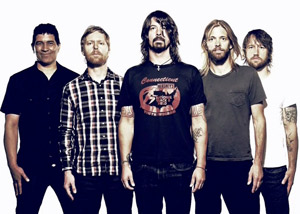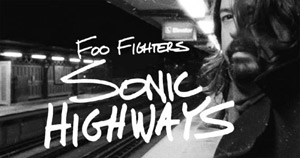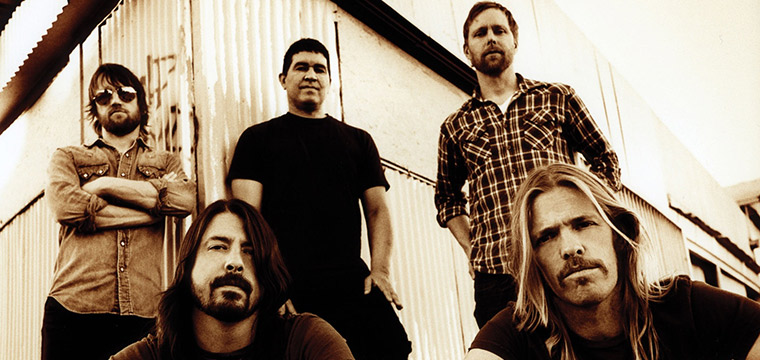 Foo Fighters is what I call a “phoenix” band. Not because they got a degree online, but because they have risen from the ashes of a band that faded too soon. Like New Order came from Joy Division, Foo Fighters was born in the wake of Nirvana’s end. In the 20 years since its inception, Foo Fighters have become one of the biggest rock bands in the world. Selling millions of albums in over 20 countries, Dave Grohl, Pat Smear, Nate Mendel, Taylor Hawkins, and Chris Shiflett have figured out the formula for recording rock music that gives your neck a workout. In 2011, along with Nirvana’s Nevermind producer Butch Vig , the band embarked on an ambitious project to record an album in Grohl’s garage using only analog equipment. That endeavor became the Grammy award winning album Wasting Light, and the follow-up to that commercial success is an even bigger project known as Sonic Highways.
Foo Fighters is what I call a “phoenix” band. Not because they got a degree online, but because they have risen from the ashes of a band that faded too soon. Like New Order came from Joy Division, Foo Fighters was born in the wake of Nirvana’s end. In the 20 years since its inception, Foo Fighters have become one of the biggest rock bands in the world. Selling millions of albums in over 20 countries, Dave Grohl, Pat Smear, Nate Mendel, Taylor Hawkins, and Chris Shiflett have figured out the formula for recording rock music that gives your neck a workout. In 2011, along with Nirvana’s Nevermind producer Butch Vig , the band embarked on an ambitious project to record an album in Grohl’s garage using only analog equipment. That endeavor became the Grammy award winning album Wasting Light, and the follow-up to that commercial success is an even bigger project known as Sonic Highways.
“If everyone knew more about the people and places this music was made, they would feel more connected to it,” explains Dave Grohl in the first episode of HBO’s eight part mini-series which shares the album title. Instead of locking his band in the garage, Dave and company travel to eight different cities to record this new album. From the grime of Chicago’s punk rock scene to Nashville’s Grand ‘Ole Opry Sonic Highway is the ultimate road trip soundtrack for anyone interested in music history. Each song’s lyrics are inspired by the cities they were written and recorded in, making every track a unique visceral experience. “The Feast and The Famine” is a stand out song in particular due to it being recorded near Grohl’s hometown of Arlington, Virginia, just outside of Washington D.C. In the second episode of Sonic Highways Grohl describes the importance of Inner Ear Studio, and how Don  Zientara, owner of Inner Ear, “produced the entire soundtrack of my youth.” Staying true to the Washington D.C. hardcore scene, this song takes no prisoners with its pounding rhythms backed by potent lyrics like “You can’t survive as an island alone/ Black heart with a gaping wound/ Put back together by a troubled groove/ check yourself/ Wreck your brains,” which ends with a reference to the energetic Virginia-based band, Bad Brains.
Zientara, owner of Inner Ear, “produced the entire soundtrack of my youth.” Staying true to the Washington D.C. hardcore scene, this song takes no prisoners with its pounding rhythms backed by potent lyrics like “You can’t survive as an island alone/ Black heart with a gaping wound/ Put back together by a troubled groove/ check yourself/ Wreck your brains,” which ends with a reference to the energetic Virginia-based band, Bad Brains.
Besides Chicago, D.C., and Nashville the band also visits Austin, Los Angeles, New Orleans, Seattle, and New York. Sonic Highways is more than just a Foo Fighters album. It is a deconstruction of the entire recording process. Not only does producer Butch Vig have to learn how to work with all the various soundboards and studios, the band is forced to adapt to its surroundings for each song. And while the process sounds overwhelming and exhaustive, the end result is a very strong album filled with emotional peaks and valleys unlike any other Foo Fighters record. This album also feels like the band has more skin in the game, owing it to themselves and the cities they recorded each song in to make a great album. I recommend watching the HBO mini-series to get the full album experience. The stories behind each song really make the album come to life, and storytelling is what music is all about. As a “phoenix” band, the Foo Fighters was born from tragedy, and while I understand what a world without Nirvana looks like, I can’t image a world without Foo Fighters.
